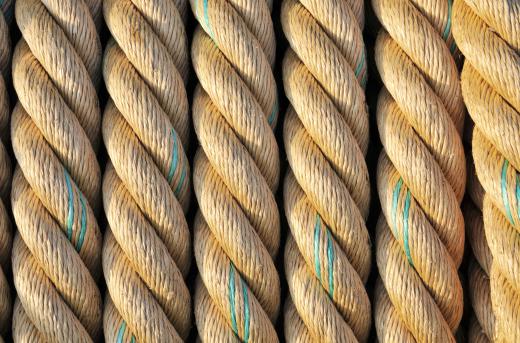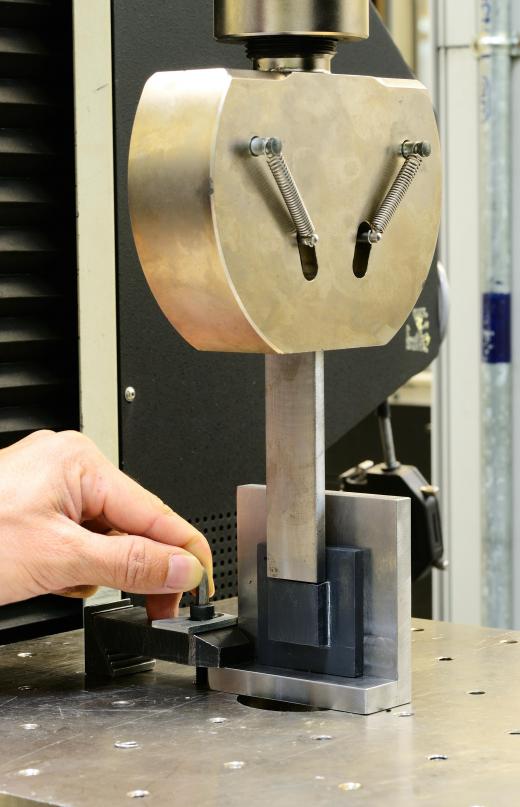Which Material Has the Most Tensile Strength?
 Michael Anissimov
Michael Anissimov
The material with the greatesttensile strength is carbon nanotube fiber. It is also the stiffest known material, with a tremendously high elastic modulus, meaning it doesn't stretch easily. Carbon nanotubes can be visualized as graphene sheets curled into cylinders just a molecule wide.
These cylinders may have single walls (SWNTs or single-walled carbon nanotubes) or multiple walls (MWNTs or multi-walled carbon nanotubes). Multi-walled carbon nanotubes have been measured as the material with the most tensile strength of all, measuring in at 63 GPa (gigapascals) for atomic-scale testing, well below the theoretical maximum of 300 GPa. Scientists have not yet been able to produce this tensile strength in bulk materials, though work is ongoing and eventual success seems likely.

In contrast to carbon nanotubes, high-carbon steel has a tensile strength of about 1.2 GPa. Bulk carbon nanotube fiber has been created with a tensile strength of 1.6 GPa, which is the most tensile strength of any fiber, natural or artificial, by over an order of magnitude. Further improvements by another order of magnitude seem plausible over the next few decades. Carbon nanotube fiber is so strong that a 50,000 km-long (31,070 mile) cord of the fiber could be extended from the Earth's surface into geosynchronous orbit and it would not break. This concept is known as a space elevator.

In May 2007, researchers funded by the US Navy succeeded in making carbon nanotubes with a length exceeding 2 mm, the longest yet. The length-width ratio of these nanotubes is approximately 900,000 to 1. The Navy is understandably interested in fibers with the most tensile strength possible, as it uses ropes for numerous purposes such as mooring, fastening cargo, etc. Stronger fibers would allow for submersible ROVs (remotely operated vehicles) to weigh more, travel deeper, and be more reliably tied to their base stations, relevant in light of a $15 million Japanese ROV, among the most advanced in the world, which was recently lost over the course of a strong storm. Thus fibers with the most tensile strength would boost our ability to explore the ocean floors.
Similar benefits could propagate into all domains of engineering and design. Bridges could be made much stronger, if carbon nanotube fiber became more affordable. Currently it costs hundreds or thousands of dollars per gram, but the cost has been falling exponentially in recent years.
AS FEATURED ON:
AS FEATURED ON:












Discussion Comments
@anon18457: Luckily, a cable is made out of many fibers in parallel. These strands are connected through friction at many places. If the location of the weakest spot of the individual fibers is distributed uniformly over the entire length, the strength of the cable becomes determined by the average fiber strength between two friction points, not the average strength of a single fiber over the entire length - just statistics.
CNT "Link" cables, already proven in the EU, make the space elevator idea very real today. Don’t you agree?
this is very cool!
it told it is stronger then diamonds and 150 times stronger than steel!
Given the benefit of a space elevator over the massive costs and risks inherent in rockets, the idea is not futile. Granted, advancements will need to be made in how the CNT is created.
Also bear in mind that a cable made from linking other cables together is as strong as the weakest segment, instead of being dependent on the entire system.
Finally, I would question the idea of such drastic degradation being tied to length, since the width is more directly related to such things. If the imperfections are spread out around the length of the cable, then the limit on the tensile strength would be determined by the weakest point of the cable. The fact that another area of the cable can only hold 10 GPa is irrelevant to the strength of a segment that can only hold 6 GPa. Thus, the limit is not directly governed by how long the cable is, but rather in the fact that you have a higher chance of critical weakness in a longer strand.
If we intend on making cables for bridges then they would have to be very long. The tensile strength of multi-walled carbon nano tubes decreases with respect to length following a logarithmic tread line due to the natural defects that occur in CNTs leaving it at circa 6 GPa for a 5m strand. To overcome this natural occurrence caused by the second law of thermodynamics we would have to expend very large amounts of energy in order to correct these defects. A perfect cable, down to the atomic level, would have to be obtained in order achieve this desire. The amount of energy input into the system in order to correct these defects would outweigh the benefits of creating such a material in the end. That energy spent trying to go against the second law should rather be concentrated on more practical methods, thus rendering the CNT bridge cables and space elevator ideas futile. Don’t you agree?
Thunder30: Bridges could be made stronger by making a rope or cord out of the nanotubes and then substituting the normal steel cords with this carbon nanotube cord. I know how bridges work as I often work on my bridge design software and submit my designs in a contest.
how could it make bridges stronger?
Post your comments